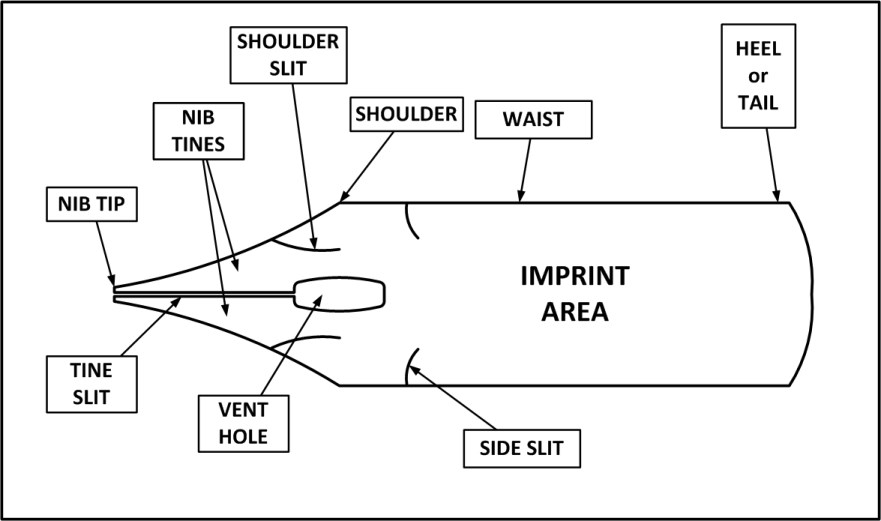PARTS of the dip pen nib:
NIB TIP
- The nib tip is the part that touches the paper and deposits ink on it
HEEL
- The heel of the nib is inserted into the pen holder
- Usually gently rounded
TINE SLIT or MAIN SLIT
- A very thin slit running between the nib tip and the vent hole
- An ink delivery channel that uses capillary action to deliver ink from the supply to the nib tip
- Some models such as music nibs may have two, three or even five main slits (very uncommon nibs)
- Straight (There is one known model from another manufacturer with a curved or serpentine tine slit)
NIB TINES
- The two sections of the nib tip separated by the tine slit
- Independently flexible
- Alignment crucial for proper operation
- Can be misaligned due to accident or mishandling
- Inspect with strong magnifying glass or jeweler's loupe
VENT HOLE
- Two purposes
- Serves to prevent or minimize cracks or splits from propagating due to flex
- Serves as an ink reservoir using surface tension
- Various shapes, some decorative, some plain
- May not exist on some nibs
- Red ink nibs
- Some stubs
- May have multiple holes on some nibs
- Usually lined up along main slit
- Music nibs have a vent hole for each main slit arranged in a lateral arc
SHOULDER
- The point where the nib body either breaks sharply or tapers towards the nib tip
- Some nibs have no definable shoulder but taper in a gentle curve all the way to the nib tip
SHOULDER SLITS
- Usually found between the shoulder and the nib tip
- Usually one slit on each side
- Increases flex by decreasing cross section area of metal
SIDE SLITS
- May be found behind the shoulder on sides of the nib body
- Straight, curved, "T", or "L" shape
- May be very wide compared to tine slits
- Increases flex by decreasing cross sectional area of metal
- Adds some difficulty level when trying to clean nib
WAIST
- Area between the vent hole and the imprint area
- Normally plain and unremarkable
- Some decorative wasp waists made
- Balance spring wasp waist intended to give softer feel to writing experience
EMBOSSING
- Usually decorative and found between the vent hole and the imprint area if present
- A raised relief surface (embossing)
- This could be in the form of a letter such as "J" or "G"
- Could be a decorative design, such as a rose, a swan, or William Shakespeare
- Could be a rolled line in the waist area
- Decorative scroll, leaves, etc. in the area of a wasp waist
IMPRINT AREA
- The area between the waist and the heel where letters and numbers are stamped onto the nib body
- Manufacturer's name
- Nib number and name
- Trademark
- City and/or country of company
- Some imprints, such as the nib number, may be located further forward, as far as the waist or the vent hole
- Many
nib manufacturers contracted with businesses or schools to put the
customer's name rather than the manufacturer's name in the imprint area
for advertising purposes
- This is a significant area of collecting
- Identifying the manufacturer can be problematical without good reference sources
NIB GRIND (not shown)
- The top or nose of the nib tip may show lateral grind marks
- Later production nibs may show crimped rows
- Intended to increase flex by decreasing thickness of metal in nib tip area
|



